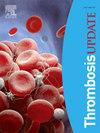National and regional incidence patterns of venous thromboembolism in Finland during 1998–2021 with corresponding mortality trends in 1998–2019
Q4 Medicine
引用次数: 0
Abstract
Objectives
Previous research suggest that venous thromboembolism (VTE) -related mortality have been declining over the recent decades, despite the increasing trend of pulmonary embolism (PE) incidence. There is evidence of some regional differences in VTE incidence. We wanted to evaluate the national and regional 21st century VTE incidence in Finland, as well as respective national VTE mortality trends.
Patients and methods
In this nationwide registry study, anonymous participants were patients with VTE diagnoses (I26 or I80) during hospital visits or VTE-related documentation of primary cause of death. To assess incidence, we recorded VTE-related hospital visits from the HILMO registry of the Finnish Institute for Health and Welfare. To assess mortality, we recorded deaths with a VTE diagnosis as a primary cause of death from the registries of Statistics Finland. Additionally, we acquired the data about pulmonary CT angiographies from STUK, which is the radiation and nuclear safety authority in Finland.
Results
At the national level, the PE incidence doubled during the study period, while the incidence rates of deep vein thrombosis remained stable. Some regional variances in VTE incidence were encountered. The usage of radiological examinations to diagnose PE have become more frequent during the study period. The mortality for VTE peaked in 2004, following the clear declining trend during the follow-up period.
Conclusion
Despite the remarkable increase in PE incidence, the mortality rates have been constantly declining from 2004. These results are valuable for the future epidemiological research of VTE.
1998-2021年芬兰静脉血栓栓塞的国家和地区发病率模式以及1998-2019年相应的死亡率趋势
目的先前的研究表明,近几十年来,尽管肺栓塞(PE)的发病率呈上升趋势,但静脉血栓栓塞(VTE)相关的死亡率一直在下降。有证据表明静脉血栓栓塞的发病率存在一些地区差异。我们想评估21世纪芬兰国家和地区静脉血栓栓塞发病率,以及各自国家静脉血栓栓塞死亡率趋势。患者和方法在这项全国性的登记研究中,匿名参与者是在医院就诊期间被诊断为静脉血栓栓塞(I26或I80)或有静脉血栓栓塞相关主要死因记录的患者。为了评估发病率,我们记录了芬兰健康与福利研究所HILMO登记处与vte相关的医院就诊情况。为了评估死亡率,我们从芬兰统计局登记处记录了静脉血栓栓塞诊断为主要死因的死亡病例。此外,我们从芬兰的辐射和核安全权威机构STUK获得了肺部CT血管造影的数据。结果在全国范围内,PE发病率在研究期间翻了一番,而深静脉血栓的发病率保持稳定。静脉血栓栓塞的发生率存在一些区域差异。在研究期间,影像学检查诊断PE的频率越来越高。静脉血栓栓塞的死亡率在2004年达到顶峰,在随访期间呈明显下降趋势。结论自2004年以来,尽管PE发病率显著上升,但死亡率却在不断下降。这些结果对今后静脉血栓栓塞的流行病学研究具有一定的参考价值。
本文章由计算机程序翻译,如有差异,请以英文原文为准。
求助全文
约1分钟内获得全文
求助全文

 求助内容:
求助内容: 应助结果提醒方式:
应助结果提醒方式:


